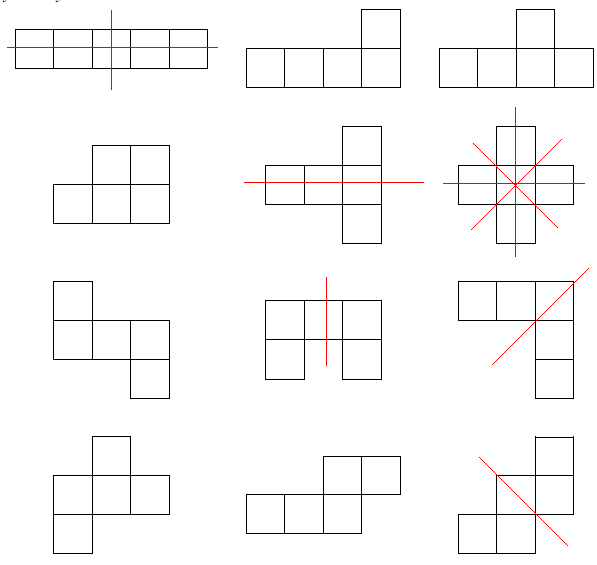Difference between revisions of "2001 AMC 10 Problems/Problem 5"
Pidigits125 (talk | contribs) (→Solution) |
|||
| (6 intermediate revisions by 6 users not shown) | |||
| Line 1: | Line 1: | ||
== Problem == | == Problem == | ||
| − | How many of the twelve pentominoes pictured below at least one line of symmetry? | + | How many of the twelve pentominoes pictured below have at least one line of reflectional symmetry? |
| − | <math> \textbf{(A)} | + | <asy> |
| + | unitsize(5mm); | ||
| + | defaultpen(linewidth(1pt)); | ||
| + | draw(shift(2,0)*unitsquare); | ||
| + | draw(shift(2,1)*unitsquare); | ||
| + | draw(shift(2,2)*unitsquare); | ||
| + | draw(shift(1,2)*unitsquare); | ||
| + | draw(shift(0,2)*unitsquare); | ||
| + | draw(shift(2,4)*unitsquare); | ||
| + | draw(shift(2,5)*unitsquare); | ||
| + | draw(shift(2,6)*unitsquare); | ||
| + | draw(shift(1,5)*unitsquare); | ||
| + | draw(shift(0,5)*unitsquare); | ||
| + | draw(shift(4,8)*unitsquare); | ||
| + | draw(shift(3,8)*unitsquare); | ||
| + | draw(shift(2,8)*unitsquare); | ||
| + | draw(shift(1,8)*unitsquare); | ||
| + | draw(shift(0,8)*unitsquare); | ||
| + | draw(shift(6,8)*unitsquare); | ||
| + | draw(shift(7,8)*unitsquare); | ||
| + | draw(shift(8,8)*unitsquare); | ||
| + | draw(shift(9,8)*unitsquare); | ||
| + | draw(shift(9,9)*unitsquare); | ||
| + | draw(shift(6,5)*unitsquare); | ||
| + | draw(shift(7,5)*unitsquare); | ||
| + | draw(shift(8,5)*unitsquare); | ||
| + | draw(shift(7,6)*unitsquare); | ||
| + | draw(shift(7,4)*unitsquare); | ||
| + | draw(shift(6,1)*unitsquare); | ||
| + | draw(shift(7,1)*unitsquare); | ||
| + | draw(shift(8,1)*unitsquare); | ||
| + | draw(shift(6,0)*unitsquare); | ||
| + | draw(shift(7,2)*unitsquare); | ||
| + | draw(shift(11,8)*unitsquare); | ||
| + | draw(shift(12,8)*unitsquare); | ||
| + | draw(shift(13,8)*unitsquare); | ||
| + | draw(shift(14,8)*unitsquare); | ||
| + | draw(shift(13,9)*unitsquare); | ||
| + | draw(shift(11,5)*unitsquare); | ||
| + | draw(shift(12,5)*unitsquare); | ||
| + | draw(shift(13,5)*unitsquare); | ||
| + | draw(shift(11,6)*unitsquare); | ||
| + | draw(shift(13,4)*unitsquare); | ||
| + | draw(shift(11,1)*unitsquare); | ||
| + | draw(shift(12,1)*unitsquare); | ||
| + | draw(shift(13,1)*unitsquare); | ||
| + | draw(shift(13,2)*unitsquare); | ||
| + | draw(shift(14,2)*unitsquare); | ||
| + | draw(shift(16,8)*unitsquare); | ||
| + | draw(shift(17,8)*unitsquare); | ||
| + | draw(shift(18,8)*unitsquare); | ||
| + | draw(shift(17,9)*unitsquare); | ||
| + | draw(shift(18,9)*unitsquare); | ||
| + | draw(shift(16,5)*unitsquare); | ||
| + | draw(shift(17,6)*unitsquare); | ||
| + | draw(shift(18,5)*unitsquare); | ||
| + | draw(shift(16,6)*unitsquare); | ||
| + | draw(shift(18,6)*unitsquare); | ||
| + | draw(shift(16,0)*unitsquare); | ||
| + | draw(shift(17,0)*unitsquare); | ||
| + | draw(shift(17,1)*unitsquare); | ||
| + | draw(shift(18,1)*unitsquare); | ||
| + | draw(shift(18,2)*unitsquare);</asy> | ||
| + | |||
| + | <math>\textbf{(A) } 3 \qquad\textbf{(B) } 4 \qquad\textbf{(C) } 5 \qquad\textbf{(D) } 6 \qquad\textbf{(E) } 7</math> | ||
== Solution == | == Solution == | ||
| − | + | [[File:Pentonimoes.gif]] | |
The ones with lines over the shapes have at least one line of symmetry. Counting the number of shapes that have line(s) on them, | The ones with lines over the shapes have at least one line of symmetry. Counting the number of shapes that have line(s) on them, | ||
we find <math> \boxed{\textbf{(D)}\ 6} </math> pentominoes. | we find <math> \boxed{\textbf{(D)}\ 6} </math> pentominoes. | ||
| + | |||
| + | ==Video Solution by Daily Dose of Math== | ||
| + | |||
| + | https://youtu.be/svFpNvUUY7E?si=CloMWtqbbhBNgWy_ | ||
| + | |||
| + | ~Thesmartgreekmathdude | ||
== See Also == | == See Also == | ||
{{AMC10 box|year=2001|num-b=4|num-a=6}} | {{AMC10 box|year=2001|num-b=4|num-a=6}} | ||
| + | {{MAA Notice}} | ||
Latest revision as of 15:11, 15 July 2024
Problem
How many of the twelve pentominoes pictured below have at least one line of reflectional symmetry?
![[asy] unitsize(5mm); defaultpen(linewidth(1pt)); draw(shift(2,0)*unitsquare); draw(shift(2,1)*unitsquare); draw(shift(2,2)*unitsquare); draw(shift(1,2)*unitsquare); draw(shift(0,2)*unitsquare); draw(shift(2,4)*unitsquare); draw(shift(2,5)*unitsquare); draw(shift(2,6)*unitsquare); draw(shift(1,5)*unitsquare); draw(shift(0,5)*unitsquare); draw(shift(4,8)*unitsquare); draw(shift(3,8)*unitsquare); draw(shift(2,8)*unitsquare); draw(shift(1,8)*unitsquare); draw(shift(0,8)*unitsquare); draw(shift(6,8)*unitsquare); draw(shift(7,8)*unitsquare); draw(shift(8,8)*unitsquare); draw(shift(9,8)*unitsquare); draw(shift(9,9)*unitsquare); draw(shift(6,5)*unitsquare); draw(shift(7,5)*unitsquare); draw(shift(8,5)*unitsquare); draw(shift(7,6)*unitsquare); draw(shift(7,4)*unitsquare); draw(shift(6,1)*unitsquare); draw(shift(7,1)*unitsquare); draw(shift(8,1)*unitsquare); draw(shift(6,0)*unitsquare); draw(shift(7,2)*unitsquare); draw(shift(11,8)*unitsquare); draw(shift(12,8)*unitsquare); draw(shift(13,8)*unitsquare); draw(shift(14,8)*unitsquare); draw(shift(13,9)*unitsquare); draw(shift(11,5)*unitsquare); draw(shift(12,5)*unitsquare); draw(shift(13,5)*unitsquare); draw(shift(11,6)*unitsquare); draw(shift(13,4)*unitsquare); draw(shift(11,1)*unitsquare); draw(shift(12,1)*unitsquare); draw(shift(13,1)*unitsquare); draw(shift(13,2)*unitsquare); draw(shift(14,2)*unitsquare); draw(shift(16,8)*unitsquare); draw(shift(17,8)*unitsquare); draw(shift(18,8)*unitsquare); draw(shift(17,9)*unitsquare); draw(shift(18,9)*unitsquare); draw(shift(16,5)*unitsquare); draw(shift(17,6)*unitsquare); draw(shift(18,5)*unitsquare); draw(shift(16,6)*unitsquare); draw(shift(18,6)*unitsquare); draw(shift(16,0)*unitsquare); draw(shift(17,0)*unitsquare); draw(shift(17,1)*unitsquare); draw(shift(18,1)*unitsquare); draw(shift(18,2)*unitsquare);[/asy]](http://latex.artofproblemsolving.com/0/8/2/082aa547e6b283dd68e0d1c407fbe9b93aeb0eca.png)
![]()
Solution
The ones with lines over the shapes have at least one line of symmetry. Counting the number of shapes that have line(s) on them,
we find ![]() pentominoes.
pentominoes.
Video Solution by Daily Dose of Math
https://youtu.be/svFpNvUUY7E?si=CloMWtqbbhBNgWy_
~Thesmartgreekmathdude
See Also
| 2001 AMC 10 (Problems • Answer Key • Resources) | ||
| Preceded by Problem 4 |
Followed by Problem 6 | |
| 1 • 2 • 3 • 4 • 5 • 6 • 7 • 8 • 9 • 10 • 11 • 12 • 13 • 14 • 15 • 16 • 17 • 18 • 19 • 20 • 21 • 22 • 23 • 24 • 25 | ||
| All AMC 10 Problems and Solutions | ||
The problems on this page are copyrighted by the Mathematical Association of America's American Mathematics Competitions. 










